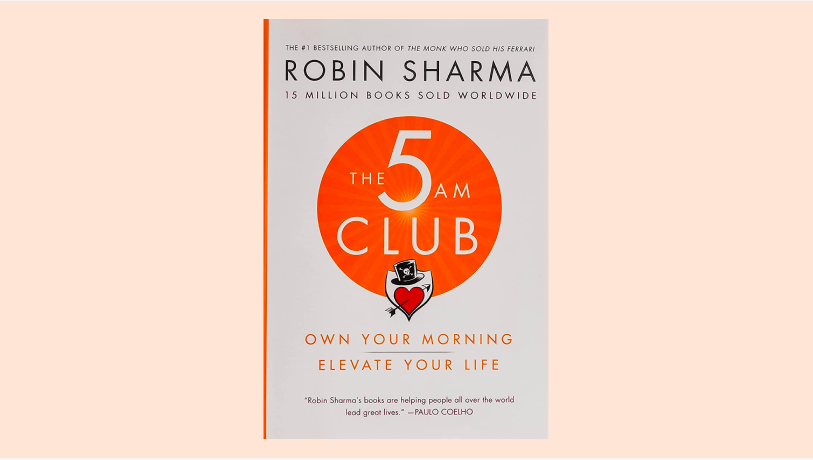Waking up at 5:00 a.m. isn’t a badge of honor; it’s a strategy. In The 5AM Club, Robin Sharma argues that the quietest hour of the day is the most leverageable: no notifications, no meetings, no mental clutter.
He packages this idea inside a teaching fable: an artist and an entrepreneur learn from a quirky billionaire mentor, that’s less about fiction and more about giving tools you’ll actually try the next morning.
This summary provides the essence without the fluff: what the 20/20/20 blocks look like, how to make 5:00 a.m. (or simply “earlier than now”) a reality, and which supporting frameworks prevent burnout while compounding small wins.
Use it to run a low-friction experiment, because whether you wake at five or five-thirty, the point is the same: start on offense, not defense.
Overview
The 5AM Club is a self-improvement fable wrapped around a simple idea: if you win the first hour of your day, you tilt the rest of it in your favor. Through the journey of an artist and an entrepreneur mentored by a billionaire, Sharma introduces the “Victory Hour,” a 60-minute block from 5:00–6:00 a.m. built on the 20/20/20 Formula.
First, you move vigorously to raise heart rate, clear cortisol, and boost neurochemistry. Then you reflect, whether by journaling, meditating, praying, or planning, to stabilize emotions and set intention. Finally, you grow by reading, studying, or practicing a skill, allowing your knowledge to compound before distractions appear.
To keep the routine from becoming a productivity-only grind, Sharma anchors it in the “4 Interior Empires”: Mindset, Heartset, Healthset, and Soulset.
The premise is that outer results mirror inner conditions; sharpening beliefs without tending to emotional fitness, physical vitality, and a sense of meaning creates lopsided success. The morning hour is therefore a daily practice in aligning thought, feeling, body, and purpose.
Sharma also explains how habits actually take root. His 66-day Habit Installation Protocol unfolds in three stages: Destruction, Installation, and Integration, so readers expect friction rather than interpret it as failure.
The early phase feels awkward as old patterns are dismantled; the middle phase is repetitive and unglamorous; the final phase is where discipline turns into identity and the routine becomes automatic.
Performance, in Sharma’s view, rises when you alternate intensity with renewal. He calls this the Twin Cycles of Elite Performance: commit to deep, undistracted work, then step back into deliberate recovery (sleep, solitude, nature, and play) to protect creativity and stamina.
Environment design supports both: lay out workout clothes the night before, keep your phone out of the bedroom, and curate a learning list so the first hour runs on rails.
To push meaningful projects forward once the day begins, the book offers two tactical rules. The 90/90/1 rule asks you to spend the first 90 minutes of your workday, for 90 days, on one mission-critical task.
The 60/10 method cycles 60 minutes of mono-focus with a short renewal break to maintain momentum without burnout. Together with the Victory Hour, these guardrails shift you from a reactive schedule to a life built around high-leverage actions.
Ultimately, The 5AM Club isn’t dogmatic about the clock; it’s prescriptive about intention. Wake earlier than you do now, claim an hour designed for your body, mind, and craft, and let small, quiet wins compound into outsized results.
Key Takeaways From “The 5AM Club”
Own the first hour
A consistent 5:00 a.m. start puts you on offense before the world makes demands. That calm, distraction-free hour sets the tone for focus, confidence, and better choices all day.
Run the 20/20/20 Formula
Spend 20 minutes moving (sweat to lower cortisol and wake the brain), 20 minutes reflecting (journal, meditate, plan), and 20 minutes growing (read, study, practice a skill). The order matters: physiology → psychology → productivity.
Train the 4 Interior Empires
Balance Mindset (beliefs), Heartset (emotional fitness), Healthset (physical vitality), and Soulset (purpose). Outer achievement won’t last if the inner foundation is lopsided.
Expect the 66-day habit arc
Change feels awkward before it feels automatic. Sharma frames it as Destruction (1–22), Installation (23–44), and Integration (45–66). Knowing the stages keeps you from quitting in the messy middle.
Protect deep work with 90/90/1
For the next 90 days, spend the first 90 minutes of your workday on one mission-critical task. This concentrates your best energy on the thing that moves the needle most.
Sustain intensity with 60/10 cycles
Work in 60 minutes of mono-focus followed by a 10-minute renewal break. Short resets preserve attention, creativity, and mood across long stretches.
Design a friction-free environment
Lay out workout clothes, prep your journal and book, set the coffee timer, and charge your phone outside the bedroom. If it’s easy to start, you’ll start.
Guard sleep like a pro
A powerful morning begins the night before: consistent bedtime, digital sunset, and a simple wind-down ritual. Better sleep quality makes 5:00 a.m. sustainable, not miserable.
Use the Tight Bubble of Total Focus
Create boundaries (time blocks, closed door, notification limits) so your best hours aren’t sliced thin by interruptions. You control access to your attention.
Measure what matters
Track wake time, the three 20-minute blocks, and one outcome metric (pages read, minutes trained, or progress on a key project). What you measure, you improve.
Let small wins compound
Ten quiet, disciplined mornings beat one heroic sprint. The real power is in the flywheel; tiny, repeatable gains that stack over weeks and months.
Treat discomfort as data
Early resistance, sleepiness, or boredom often signals neural rewiring, not failure. Adjust inputs (bedtime, nutrition, workout intensity) before abandoning the habit.
Recover deliberately
Elite performance alternates deep focus with deep recovery: sleep, solitude, nature, play. Rest isn’t a reward after productivity; it’s a prerequisite for it.
Customize, don’t idolize 5:00 a.m.
The principle is intentional ownership of your first hour, not the exact minute on the clock. If needed, start 30–45 minutes earlier than now and scale the routine (e.g., 15/15/15).
Anchor purpose to practice
Connect the routine to who you want to become (a leader, creator, or healthier parent), so the habit is identity-driven, not just willpower-driven.
About the Author
Robin Sharma is a Canadian writer and leadership advisor best known for blending fable-style storytelling with practical frameworks for personal mastery.
A former litigation lawyer, he first broke out with The Monk Who Sold His Ferrari, a parable about purpose and discipline that set the tone for his later work on habits, peak performance, and service-driven leadership.
Sharma’s books, including The Leader Who Had No Title, The 5AM Club, and The Everyday Hero Manifesto, center on a consistent theme: lasting excellence begins with daily rituals that strengthen character, focus, health, and meaning.
Beyond writing, he delivers keynotes and advises executives, entrepreneurs, and creatives on building cultures of deep work and high standards without burning out.
His influence comes less from academic theory and more from translating timeless ideas into simple, repeatable practices. The 5AM Club is a hallmark of that approach, turning a story into a concrete morning system that readers can test the very next day.
Final Thoughts
The 5AM Club isn’t really about an alarm time; it’s about intent. Claiming the first quiet hour to move, reflect, and grow gives you the clarity and stamina to do the work that actually moves your life forward.
Treat it as a 66-day experiment: protect your evenings, run the 20/20/20 blocks, and measure one outcome that matters. Small, consistent mornings compound into big, durable wins.
If your 5 a.m. is for deep work, free up the rest of your day by delegating the busywork. South can help you find vetted, time-zone-aligned talent in Latin America, including project managers, assistants, analysts, developers, and more, so you stay focused on the highest-leverage tasks.
Ready to build your support bench? Schedule a free call to get matched with remote talent today!




.png)

